The battle
August 21st: the end of German 7th Army
Canadian relief
After the massacres of the day, night came as a relief for both Poles and Germans. As 84th Corps had previously ran into positions of 10th PSK being largely captured in the result, and 47th Corps was to finish its exit later that night, the less mobile 74th Corps took the direction of hill 262. Rearguard was formed by remains of 116th PzD, which was retreating from Argentan. As the shattered polish troops had very limited possibilities to intervene, and Germans were primarily looking to escape, both camps were now avoiding contact. As a result, fighting was only very sporadic, but the night was punctuated by regular artillery salvos giving rough time to German troops.
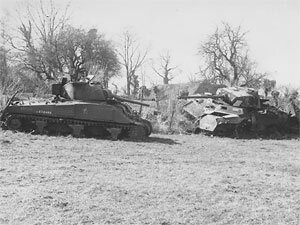 August 21st, 1944 – In front of Boisjos, a Sherman faces a Panther.
August 21st, 1944 – In front of Boisjos, a Sherman faces a Panther.
Both tanks engaged each other simultaneously and were subsequ-
ently destroyed. This picture illustrates well the extreme violence of
the contest on hill 262.
Soon in the morning, some C47 Dakota dropped ammunition containers, but because of a navigation mistake, most of them felt unfortunately on Canadian positions on hill 240. Only a small part of them reached polish hands. This missed attempt to resupply Poles proved particularly sad, as German attacks resumed soon after with increased violence. Even if after two days of merciless fighting Germans could no more deliver organised and coordinated attacks, their assault reached the last polish defenders. Again, massive support of polish artillery and 4th Canadian medium gun stopped Germans meters from polish positions. Tanks of the armoured regiments used their last rounds and finished the work of artillery.
Just before noon, some fanatic SS troops launched a last assault on 9th rifle battalion overhanging the church of Coudehard. To save their last rounds, polish rifles let them come closer then annihilated the SS waves at point blank range. Despite it was using its last rounds, answer of 9th rifles was particularly savage and soon, tens of German bodies piled up around the church.
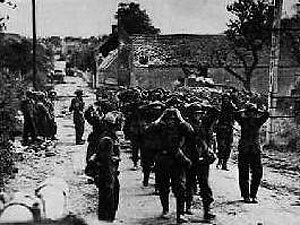 August 21st, 1944 - in Saint-Lambert, more and more soldiers make
August 21st, 1944 - in Saint-Lambert, more and more soldiers make
the choice to surrender rather than to continue a desperate fight. It was midday when the first tanks from Canadian Grenadier Guards finally arrived below Boisjos, but a thin curtain of German troops was still separating them from the Poles. To operate the junction, a part of defenders of Maczuga attacked with fixed bayonets in an ultimate and bloody charge. Soon, German lines were hustled and Canadian tanks started to arrive on Maczuga, to the great relief of Stefanowicz. Suddenly, a lone Panther managed to make its way to the polish field hospital situated in Boisjos and fired on the wounded and on approaching Canadians. It tried then to escape in direction of Champosoult, but was soon destroyed by a Sherman – both enemies fired at each other in the same time, resulting in mutual destruction.
It was to be the last major threat. The arrival of the Canadians allowed Poles to be supplied and to evacuate their casualties. Beginning of the afternoon, some desperate Germans launched local attacks in the sector held by 1st armoured regiment but having now been supplied in ammunition, this latter repulsed them easily. In the afternoon, 2nd and 9th SS-PzD received orders to withdraw on Champosoult, then Vimoutiers, then the Seine.
Inside the pocket, this day of August 21st was spent mainly on collecting remaining prisoners. Several hundreds surrendered on the bridges of Saint-Lambert, meantime reached by the Currie group. More than 700 others surrendered in Tournai, abbot Launay being in charge of negotiating the truce with Americans. During the night, some isolated elements – at least one Panther from the rearguard 116th PzD – still succeeded in escaping, benefiting from general confusion. August 22nd, around 4 AM, Canadians of the 3rd infantry division captured one hundred Germans in the plain. The Battle of the Falaise pocket was over.
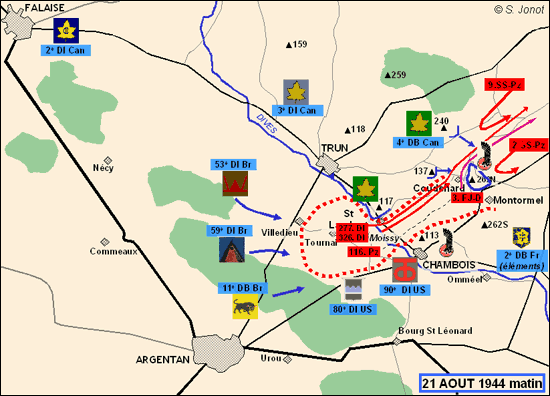
Assessment of the Falaise pocket battle
When Canadian of the 4th armoured division finally reached the Poles on Maczuga, they found a picture issued from a Dantesque tragedy. Piled up all over, thousands of German bodies, entangled in grotesque positions with burnt-out vehicles and remains of all sorts of military equipment, covered fields and orchards. Dead horses, broken gun carriages, tanks, strewed over a countryside devastated by artillery shells, aviation bombs, and automatic weaponry. In the places where fighting has been the most bitter, Polish and German soldiers laid aside, united in death after an ultimate hand to hand contest. The odour of blood and death started to give off around casualty clearing stations. From the Poles originally arrived on the hill two days sooner, there remained 4 able-bodied officers out of 60 and less than 100 other ranks suited for combat out of 2000. On 87 tanks arrived on the “Mace”, less than thirty were still undamaged. Hill 262, called Maczuga by the Poles, became thus for the Canadians the “Polish Battlefield”.
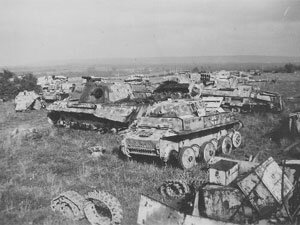 German equipment destroyed in the Montormel area and gathered
German equipment destroyed in the Montormel area and gathered
in the Dives valley for being scrapped. In Saint Lambert sur Dives, where the combat group of major Currie had destroyed 7 enemy tanks, ten 88 mm guns, and more than 40 other vehicles, the spectacle was similar. Ten Sherman were finishing burning out, and hundreds of prisoners piled up in the orchards. However, because of the relative continuity of the front line, it had been possible to evacuate casualties.
The battle finished, it was time for an account. In addition to a report of absolute horror, it is the imbalance of the losses which struck more. On the Allies side, one deplored:
- For the 1st Polish armoured division, in both Chambois and on hill 262: 325 killed, 1002 wounded, 114 missing, it means 20% of its front-line soldiers;
- The Canadians 3rd infantry and 4th armoured divisions counted 260 men out of combat;
- The US 80th and 90th infantry divisions announced 760 losses for the same period, but these figures count for the whole Argentan – Chambois area.
In addition, some one hundred of civil victims are to be regretted.
Among Germans, losses are difficult to establish, as the pocket have not been hermetically closed until the end of the fight. It is generally agreed that when the Poles cut the Trun-Vimoutiers road in the night August 18th to 19th, 100.000 Germans were still trapped in the pocket. On this figure, until the rendering of the last groups in Tournai-sur-Dives in the morning of August 22nd, nearly 40.000 had succeeded in escaping, 50.000 were made prisoners, certainly more than 12.000 being killed. Even the elite parachutists of Meindl, who made strong impression while leaving the kessel meters from Polish positions out of ammunition, were nothing more but the shadow of once powerful 2nd Fallschirmjäger Korps. Incredibly enough, a last group of Germans hiding in case of a hypothetical German counter-offensive would surrender no sooner than… March 1945.
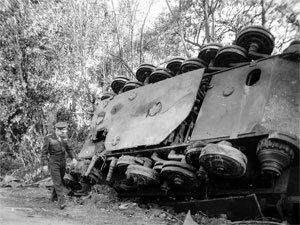 A couple of days after the battle, Allied supreme commander made
A couple of days after the battle, Allied supreme commander made
a visit of the battlefield. One to see it here beside the carcass of a
king tiger tank, destroyed in the corridor of death.
Germans left in the Falaise pocket, in addition to their manpower losses, the major part of their heavy armament: more than 200 tanks, nearly 1.000 guns (150 self-propelled, 700 towed, and around 100 AA guns), and 5.000 other vehicles, and a countless quantity of horse-drawn carts. Repairable equipment was soon collected by French army, the beyond repair one being gathered by scrap merchants, who would eventually need some thirty years to come to end with the last wrecks…
With regret, the battle of the Falaise pocket was not, as states the title of a famous book on this subject, a “Stalingrad in Normandy”. Between August 14th, when Bradley stopped the progression of Patton northward, and August 22nd, more than 100.000 Germans succeeded in escaping the Allies. Despite this relative failure, despite slowness and hesitations of allied high command, despite the absence of coordination between British and American units, one can consider the Falaise pocket marked the end of the battle of Normandy.
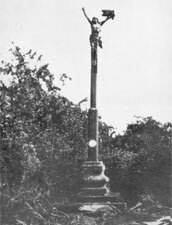 The cross of Montormel, after the battle
The cross of Montormel, after the battle
Shortly after the battle, gen. Eisenhower visited the place that, at the price of too much blood, had become the “polish battlefield”. Seeing the macabre spectacle, the allied supreme commander remembered then: “It was possible for hundreds of yards to walk over decomposing human remains, in a heavy silence, through a luxuriant countryside where all life had brutally ceased… It is one of greatest slaughters of the war”. Adopting a strategic point of view, Montgomery was to call it “the beginning of the end of the war”.













 www.evl.pl
www.evl.pl